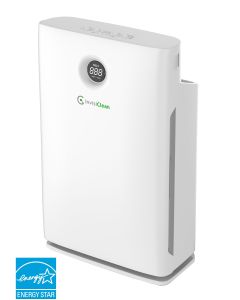With the release of the new InvisiClean Claro and Sensa Air Purifiers, one of the common questions we get is what is PM2.5. Simply put, it is a measurement of PM (Particulate Matter) in the air that is smaller than 2.5 micrometers. Human hair is about 75 micrometers in diameter, so even the largest PM2.5 particle is 30 times smaller than that!
One common misconception of PM2.5 is that it is a count of particles in the air. To clarify, PM2.5 is a weight measurement of µg (micrograms) per m³ (cubic meter). It is not a quantity measurement but a mass measurement. The way our PM2.5 meter works is by using a laser to radiate suspended particles in the air, it collects the scattering light and estimates the mass of all particles 2.5µm and under in size.
Why does it matter?
PM2.5 particulate matter contains microscopic solids or liquid droplets that are so small that they can go deep inside the lungs and into the bloodstream causing health problems. Another common misconception is that a PM2.5 measurement reflects the amount of "dust" in the air. Although it can technically be classified as dust, it is not visible to the eye like normal household dust. Household dust can be irritating but it will usually get filtered out through your nose and mouth.
Where does it come from?
Some are emitted directly from a source, some examples are construction sites, unpaved roads, fields, smokestacks, or fires. Most particles in the air are a result of complex chemical reactions of pollutants emitted from power plants, industrial manufacturing, and automobiles. Common indoor sources can also make PM2.5 levels temporarily increase such as walking by the unit and kicking up particulates, vacuuming, cooking, fireplaces, candles, humidifiers, and heaters. Temporary fluctuations caused by these sources usually will dissipate quickly and should not be a cause for concern. Long-term elevated PM2.5 levels should be of concern and the air purifier should be run at a higher speed until the levels go down.
What PM2.5 level is ok?
The ideal levels are below 100 and if you are sensitive to PM2.5, below 50 is ideal. The InvisiClean Claro will show an actual number and the InvisiClean Sensa will show blue(good), yellow(moderate), and red(bad). Blue means it is under 60, Yellow means under 150, and red means 150+. Most households should stay under 10-20 in most cases with the air purifier running. Higher levels are usually temporary when there is high traffic or activity around the air purifier.
How do I know it is working?
An easy way to test the sensor is to light a candle or match nearby and extinguish it. You should see the PM2.5 number go up or change colors depending on the model.
What setting should I run my air purifier on?
Both the InvisiClean Claro and Sensa have auto modes. In auto mode, when the PM2.5 level rises, it will automatically raise the fan speed to remove the particles in the air as fast as possible. Once the pollution source is gone, the fan speed will go back down. If your goal is to prevent PM2.5 inhalation, our recommendation is to leave it on auto. If you are trying to reduce dust and allergens, our recommendation is to leave the air purifier at the highest speed that is comfortable. That way the air purifier is constantly working to move air around and capture dust and allergens.


2 Comments